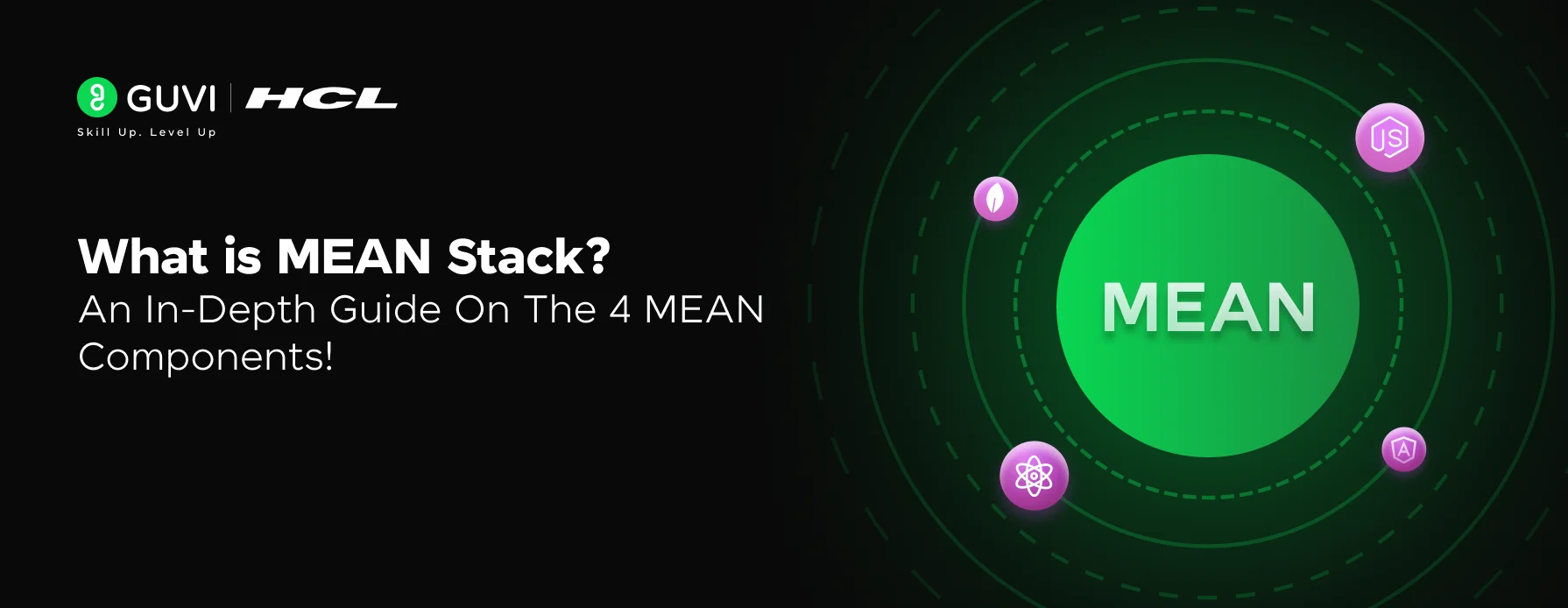
What is MEAN Stack? An In-Depth Guide On The 4 MEAN Techs!
Apr 09, 2025 6 Min Read 199 Views
(Last Updated)
If you are interested in websites, at any point, you might’ve wondered how modern web applications manage to be fast, responsive, and seamless from the user interface to the database.
Behind many of these powerful apps is a well-integrated technology stack known as the MEAN stack. Comprising MongoDB, Express.js, Angular, and Node.js, MEAN is a full-stack JavaScript framework that enables developers to build end-to-end applications with a single language.
In this article, we’ll explore what the MEAN stack is, how its components work together, and why it’s a popular choice among developers building scalable, high-performance web applications.
Table of contents
- What is MEAN Stack?
- Components of MEAN Stack
- MongoDB – The NoSQL Database
- Express.js – The Backend Web Framework
- Angular – The Frontend Framework
- Node.js – The Runtime Environment
- How MEAN Stack Works Together?
- End-to-End Workflow Example
- Seamless Integration
- Benefits of Using the MEAN Stack
- Full JavaScript Development (One Language to Rule Them All)
- Faster Development with Reusability
- Efficient Data Handling with JSON
- High Performance and Scalability
- Strong Open-Source Community & Ecosystem
- MEAN Stack Use Cases
- Single-Page Applications (SPAs)
- Real-Time Applications
- E-Commerce Platforms
- Content Management Systems (CMS)
- Cloud-Based Applications & SaaS Products
- When to Choose MEAN Stack in Development?
- You Need End-to-End JavaScript Development
- You’re Building a Single-Page Application (SPA)
- Your Application Requires Real-Time Features
- You're Prototyping or Launching an MVP
- You Want a Scalable, Maintainable Architecture
- You Value Open Source and Community Support
- When MEAN Might Not Be the Best Fit
- Conclusion
- FAQs
- What is the MEAN Stack?
- What are the advantages of using the MEAN Stack?
- How does the MEAN Stack differ from the LAMP Stack?
- Is the MEAN Stack suitable for large-scale applications?
- How can I start learning the MEAN Stack?
What is MEAN Stack?
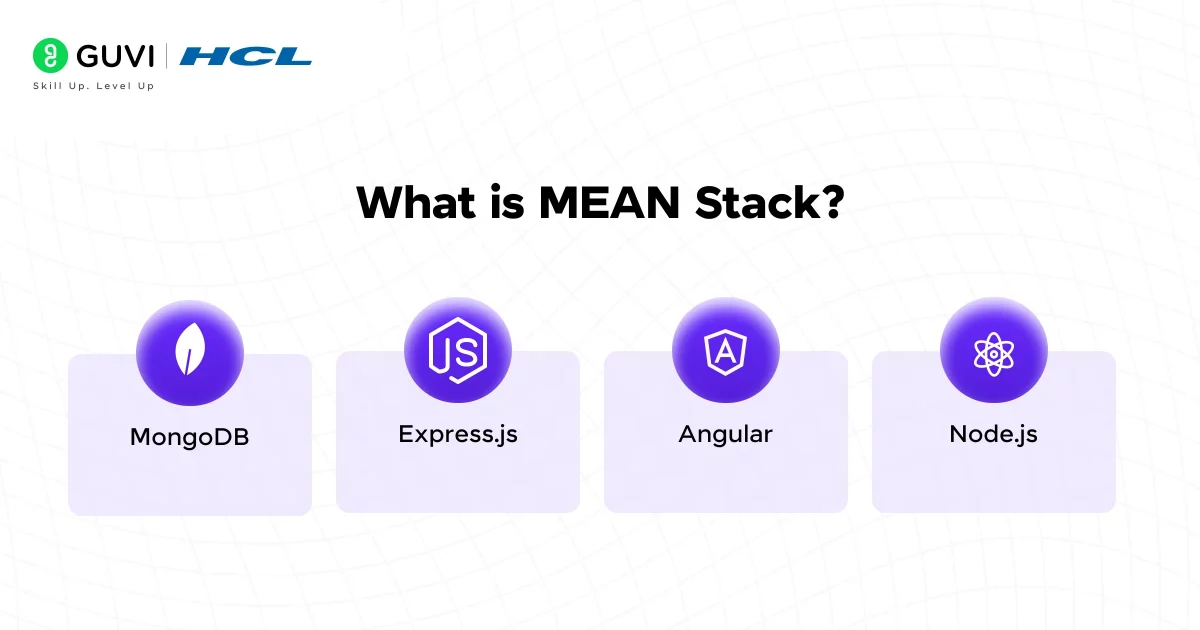
In the world of web development, MEAN stack has become a go-to solution for building robust, scalable, and maintainable full-stack applications using JavaScript.
The term MEAN is an acronym for four open-source technologies that work together to handle every aspect of a web application:
- MongoDB – the database layer
- Express.js – the backend web application framework
- Angular – the frontend development framework
- Node.js – the server-side runtime environment
The unique aspect of the MEAN stack is that all layers use JavaScript, from the database queries and server logic to the front-end UI. This uniformity enables developers to switch between front-end and back-end tasks with minimal friction, making MEAN especially popular in agile teams and startups.
Components of MEAN Stack
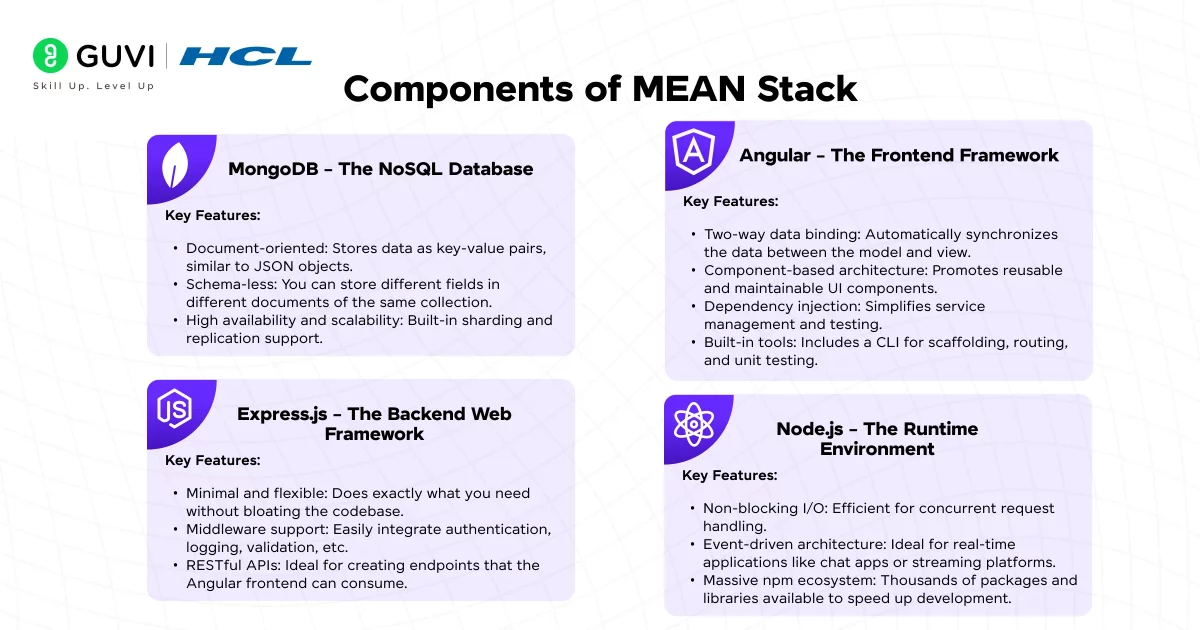
As we saw earlier, MEAN is an acronym for MongoDB, Express.js, Angular, and Node.js. It is important to understand what role each component has to play to become this important in the world of full-stack development.
So, let’s break down the four components that make up the MEAN stack and how they fit together in a typical development workflow.
1. MongoDB – The NoSQL Database
MongoDB is a NoSQL database used to store application data in a flexible, JSON-like format called BSON (Binary JSON). Unlike relational databases that use tables and schemas, MongoDB uses collections and documents, allowing for more dynamic and hierarchical data structures.
Key Features:
- Document-oriented: Stores data as key-value pairs, similar to JSON objects.
- Schema-less: You can store different fields in different documents of the same collection.
- High availability and scalability: Built-in sharding and replication support.
If you want to read more about how MongoDB works and its use cases, consider reading GUVI’s Free MongoDB for Beginners Ebook, which covers the key concepts of MongoDB, including setting up a database and updating changes to it. You’ll also learn about the top tools used by MongoDB experts to complete their tasks efficiently.
2. Express.js – The Backend Web Framework
Express.js is a lightweight web application framework built on top of Node.js. It simplifies the process of building APIs, handling HTTP requests/responses, and managing middleware — all of which are crucial for backend logic.
Key Features:
- Minimal and flexible: Does exactly what you need without bloating the codebase.
- Middleware support: Easily integrate authentication, logging, validation, etc.
- RESTful APIs: Ideal for creating endpoints that the Angular frontend can consume.
3. Angular – The Frontend Framework
Angular, developed and maintained by Google, is a powerful front-end framework designed for building dynamic, single-page applications (SPAs). It uses TypeScript, a superset of JavaScript, which offers strong typing and better tooling.
Key Features:
- Two-way data binding: Automatically synchronizes the data between the model and view.
- Component-based architecture: Promotes reusable and maintainable UI components.
- Dependency injection: Simplifies service management and testing.
- Built-in tools: Includes a CLI for scaffolding, routing, and unit testing.
4. Node.js – The Runtime Environment
Node.js is a JavaScript runtime built on Chrome’s V8 engine. It allows developers to run JavaScript on the server side, enabling full-stack JavaScript development.
Key Features:
- Non-blocking I/O: Efficient for concurrent request handling.
- Event-driven architecture: Ideal for real-time applications like chat apps or streaming platforms.
- Massive npm ecosystem: Thousands of packages and libraries available to speed up development.
How MEAN Stack Works Together?
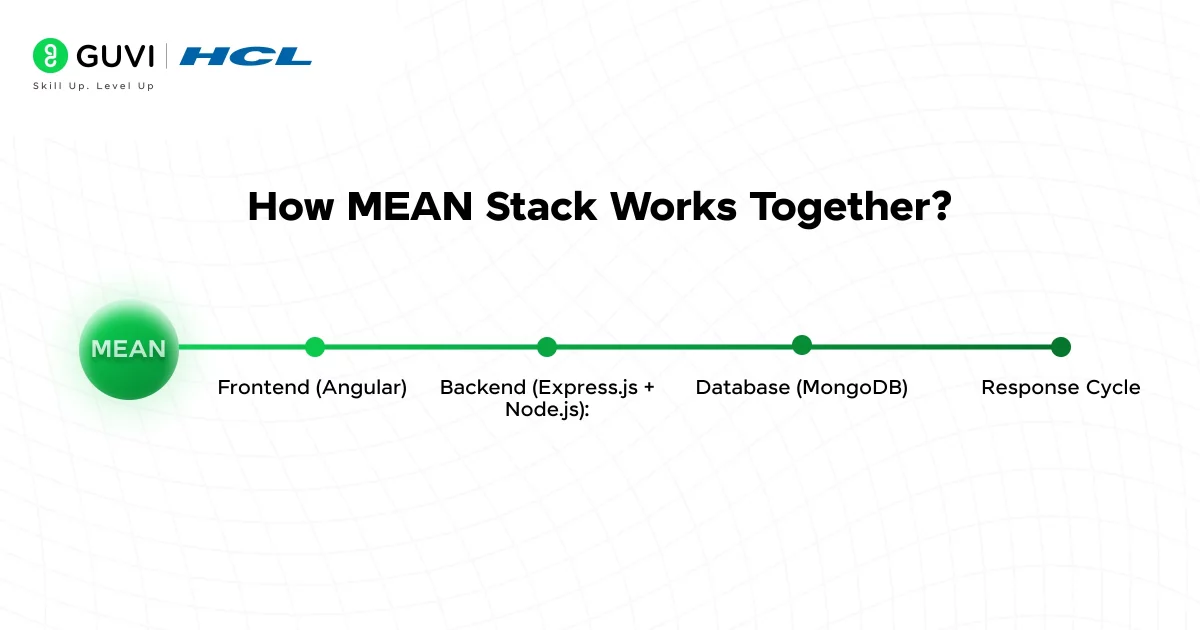
What makes the MEAN stack particularly compelling is how each layer is built to complement the others, enabling developers to build end-to-end applications using a single language: JavaScript.
Let’s walk through how the components communicate and operate together in a real-world scenario.
End-to-End Workflow Example
Imagine you’re building an online task management app. Here’s how the MEAN stack handles the flow from the user interface to the database:
- Frontend (Angular):
The user opens the web app and creates a new task using a form. Angular captures the input and sends a POST request to the backend using Angular’s HttpClient service. - Backend (Express.js + Node.js):
The request hits a route in the Express server, like POST /api/tasks. Express receives the data, validates it (using middleware), and prepares it for database operations. Node.js runs this backend environment efficiently using its non-blocking event loop. - Database (MongoDB):
The backend interacts with MongoDB (often via a library like Mongoose) to store the task in a document inside a collection. MongoDB accepts the data in JSON-like format (BSON), so no conversion is needed. - Response Cycle:
Once the task is stored, MongoDB sends a successful response. Express then sends that data back to the Angular frontend in JSON format. Angular receives the response and updates the UI to reflect the new task, without requiring a full page reload.
Seamless Integration
This seamless communication is possible because:
- All data flows in JSON, reducing the need for transformation or serialization.
- All components use JavaScript, minimizing context-switching for developers.
- The stack follows MVC (Model-View-Controller) principles — MongoDB acts as the model, Angular as the view, and Express/Node.js as the controller.
Benefits of Using the MEAN Stack
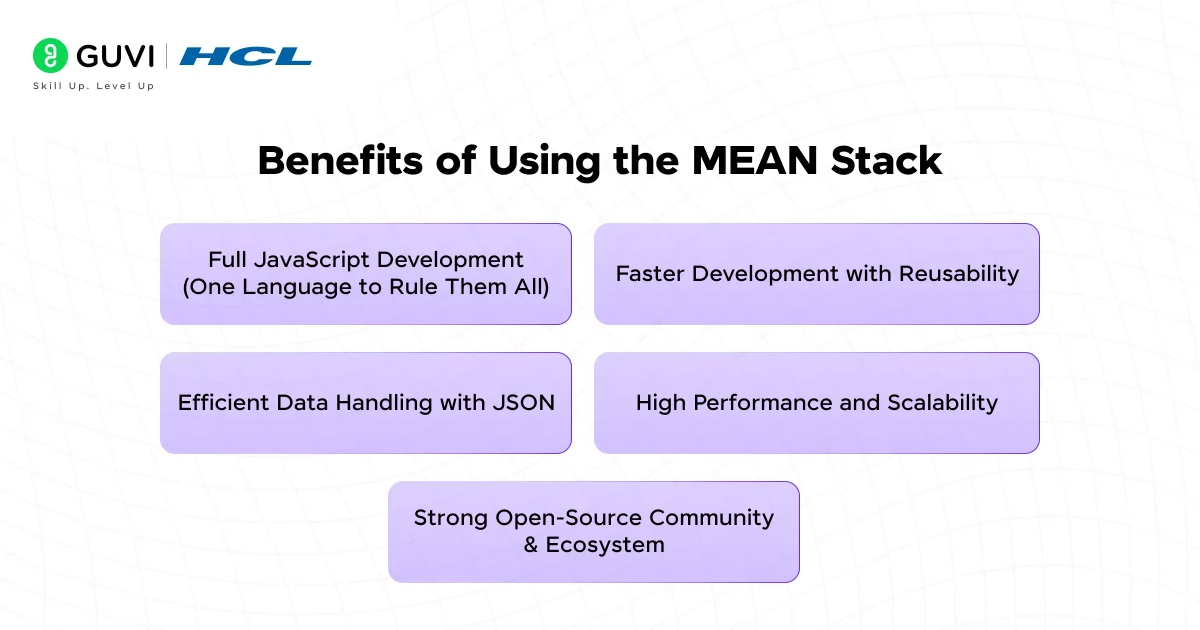
Now that you understand how the stack components work together, let’s explore why developers and companies choose the MEAN stack for building web applications.
1. Full JavaScript Development (One Language to Rule Them All)
Using JavaScript across the stack streamlines development. You don’t have to juggle between different languages for front-end, back-end, and database interactions. This reduces complexity and speeds up onboarding for new developers.
2. Faster Development with Reusability
Thanks to modular architecture and reusable components in Angular and Express, you can build, test, and scale features more rapidly. The stack supports rapid prototyping, which is especially useful in agile workflows and startups.
3. Efficient Data Handling with JSON
MongoDB and Angular both use JSON extensively, and Express/Node handle JSON natively. This allows for smooth data transport and reduces time spent on format conversions or mapping.
4. High Performance and Scalability
Node.js uses an event-driven, non-blocking I/O model. This makes it capable of handling thousands of concurrent connections — a key advantage for applications that require real-time updates or high traffic.
MongoDB, with its support for horizontal scaling and replication, adds another layer of scalability on the data side.
5. Strong Open-Source Community & Ecosystem
Each component in the MEAN stack is backed by a strong open-source community:
- Angular by Google
- Node.js is supported by OpenJS Foundation
- Express and MongoDB are maintained by thriving developer communities
You’ll find ample documentation, tutorials, and third-party tools to support your development.
The MEAN stack is predominantly used across the world as it offers a well-integrated, developer-friendly environment for building full-stack web applications using JavaScript from top to bottom.
MEAN Stack Use Cases
The MEAN stack’s versatility, scalability, and full JavaScript-based architecture make it a powerful choice for a wide range of web applications. Below are some common use cases where the MEAN stack shines and adds real value to development workflows.
1. Single-Page Applications (SPAs)
Angular’s dynamic data binding and routing make it perfect for building SPAs, where content updates dynamically without reloading the page. Express and Node provide fast backend APIs, while MongoDB handles flexible data structures for user activity, task tracking, or analytics.
Example: Project management tools, dashboards, or online collaboration platforms.
2. Real-Time Applications
Node.js’s event-driven, non-blocking I/O system is ideal for managing real-time data flow. Combined with WebSockets (like Socket.io), you can build real-time features easily. MongoDB supports real-time data handling with features like change streams, and Angular keeps the UI instantly updated.
Examples: Chat applications, live notifications, or collaborative editing tools.
3. E-Commerce Platforms
MEAN is excellent for creating scalable e-commerce apps where product listings, user authentication, and order management require dynamic and fast interactions. MongoDB’s document model fits well with varied product data, and Angular enhances UX with smooth browsing and filtering.
Examples: Online stores, order management systems, or digital marketplaces.
4. Content Management Systems (CMS)
The stack allows you to build flexible CMS solutions where users can create, edit, and manage content with real-time previews. MongoDB enables flexible content storage, while Angular makes the interface user-friendly and responsive for content creators and admins alike.
Example: Blogging platforms, knowledge bases, or custom CMS for enterprise use.
5. Cloud-Based Applications & SaaS Products
MEAN is cloud-native and works seamlessly with platforms like AWS, Azure, and MongoDB Atlas. It supports scalability, microservices architecture, and RESTful APIs, making it ideal for building and scaling SaaS applications with modern, user-centric features.
Examples: CRM systems, analytics dashboards, and online tools.
When to Choose MEAN Stack in Development?
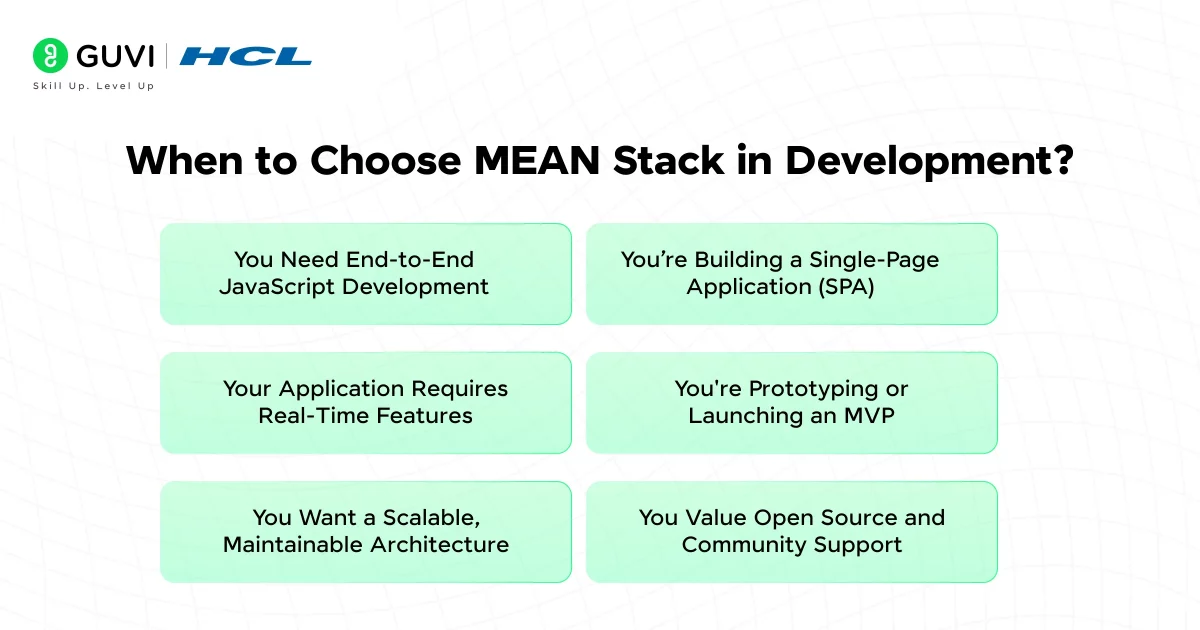
Choosing the right tech stack is a critical step in building any application. While the MEAN stack is versatile and powerful, it truly shines in specific development scenarios.
If you’re wondering whether MEAN is the right fit for your next project, here are some considerations to guide your decision.
1. You Need End-to-End JavaScript Development
If your development team is comfortable with JavaScript and you want to streamline the technology stack across the frontend, backend, and database, MEAN is an excellent choice. With MEAN, you avoid the need to hire separate developers for different layers of the stack.
Use it when:
- Your developers already have experience with JavaScript.
- You want faster onboarding and easier team collaboration.
- You’re looking to minimize context-switching between languages.
2. You’re Building a Single-Page Application (SPA)
MEAN is particularly well-suited for Single-Page Applications — applications where content updates dynamically without refreshing the page. Angular, the frontend framework in MEAN, is designed specifically for this type of architecture.
Use it when:
- You want real-time updates in the UI.
- You’re developing apps like dashboards, CRMs, project management tools, etc.
- UX and speed are top priorities.
3. Your Application Requires Real-Time Features
MEAN is ideal for applications that require real-time data handling, such as messaging apps, live feeds, notifications, or collaborative platforms. Node.js handles concurrent connections efficiently, and MongoDB’s ability to stream data changes (with tools like Change Streams) complements this setup.
Use it when:
- You’re building chat apps, collaboration tools, or live dashboards.
- Real-time responsiveness is a business-critical feature.
4. You’re Prototyping or Launching an MVP
Because of its modularity, unified language, and ready-to-use tools, MEAN is a strong contender for rapid prototyping and MVP (Minimum Viable Product) development. You can quickly spin up a project, build features iteratively, and test with users in shorter cycles.
Use it when:
- You want to validate a product idea quickly.
- You’re on a tight deadline or startup budget.
- You need to iterate based on user feedback fast.
5. You Want a Scalable, Maintainable Architecture
Thanks to Angular’s component-based frontend and Express’s middleware-based backend, MEAN applications can be structured for high maintainability and scalability. This is particularly beneficial for long-term projects that will evolve.
Use it when:
- You’re building a product you plan to scale with time.
- Code maintainability and modularity are key concerns.
- You’re working with a growing team or multiple contributors.
6. You Value Open Source and Community Support
All four technologies in MEAN are open-source, actively maintained, and backed by large developer communities. This ensures access to a wealth of plugins, documentation, and best practices.
Use it when:
- You want to reduce licensing and tech costs.
- You prefer working in open-source ecosystems.
- Community support and active development are essential to your stack.
When MEAN Might Not Be the Best Fit
While MEAN is powerful, it’s not always the optimal solution. Consider alternatives if:
- Your team is more experienced in Python (consider Django) or PHP (Laravel).
- You’re building a CPU-intensive application (Node.js is not ideal for heavy computation).
- You require a relational database with complex joins and transactions (MongoDB is document-based, not relational).
Its JavaScript-unified ecosystem, flexibility, and support for rapid development make MEAN a strategic choice for startups, product teams, and full-stack developers alike.
If you want to learn more about MEAN Stack and how it enables developers to work seamlessly, consider enrolling in GUVI’s IIT-M Pravartak-certified Full Stack Development Course that not only teaches you the basics but also makes you an experienced developer through hands-on projects guided by an actual mentor.
Conclusion
In conclusion, the MEAN stack offers a unified, efficient, and scalable solution for building dynamic web applications. Utilizing JavaScript across the entire development lifecycle, from the front-end interface to the backend logic and database layer, simplifies collaboration, accelerates development, and enhances maintainability.
The MEAN stack provides the flexibility and power needed to meet modern web demands. Understanding its core components and knowing when to use it can give you a strong edge in today’s competitive development landscape.
FAQs
The MEAN Stack is a collection of JavaScript-based technologies used to build full-stack web applications. It includes MongoDB for the database, Express.js as the backend web framework, Angular for the frontend interface, and Node.js as the server-side runtime.
One of the biggest advantages of the MEAN Stack is that it uses JavaScript across both the client and server sides, which simplifies development and reduces the need for context-switching. It supports fast, scalable, and maintainable applications.
The main difference between the MEAN and LAMP stacks lies in the technology and language used. MEAN uses JavaScript throughout its stack, making it ideal for real-time, single-page applications. In contrast, LAMP (Linux, Apache, MySQL, PHP) relies on multiple languages and tools, which can increase complexity in development.
Yes, the MEAN Stack is well-suited for building large-scale applications. Node.js’s non-blocking architecture enables it to handle high volumes of simultaneous connections, while MongoDB offers flexible and scalable data storage. Angular’s modular design supports complex front-end architectures.
To get started with the MEAN Stack, it’s important to have a solid grasp of JavaScript, as it’s the common thread across all four technologies. Begin by learning Node.js and Express.js to understand how to create and manage APIs. Then, we move on to MongoDB for database management and finally dive into Angular to build interactive front-end interfaces.


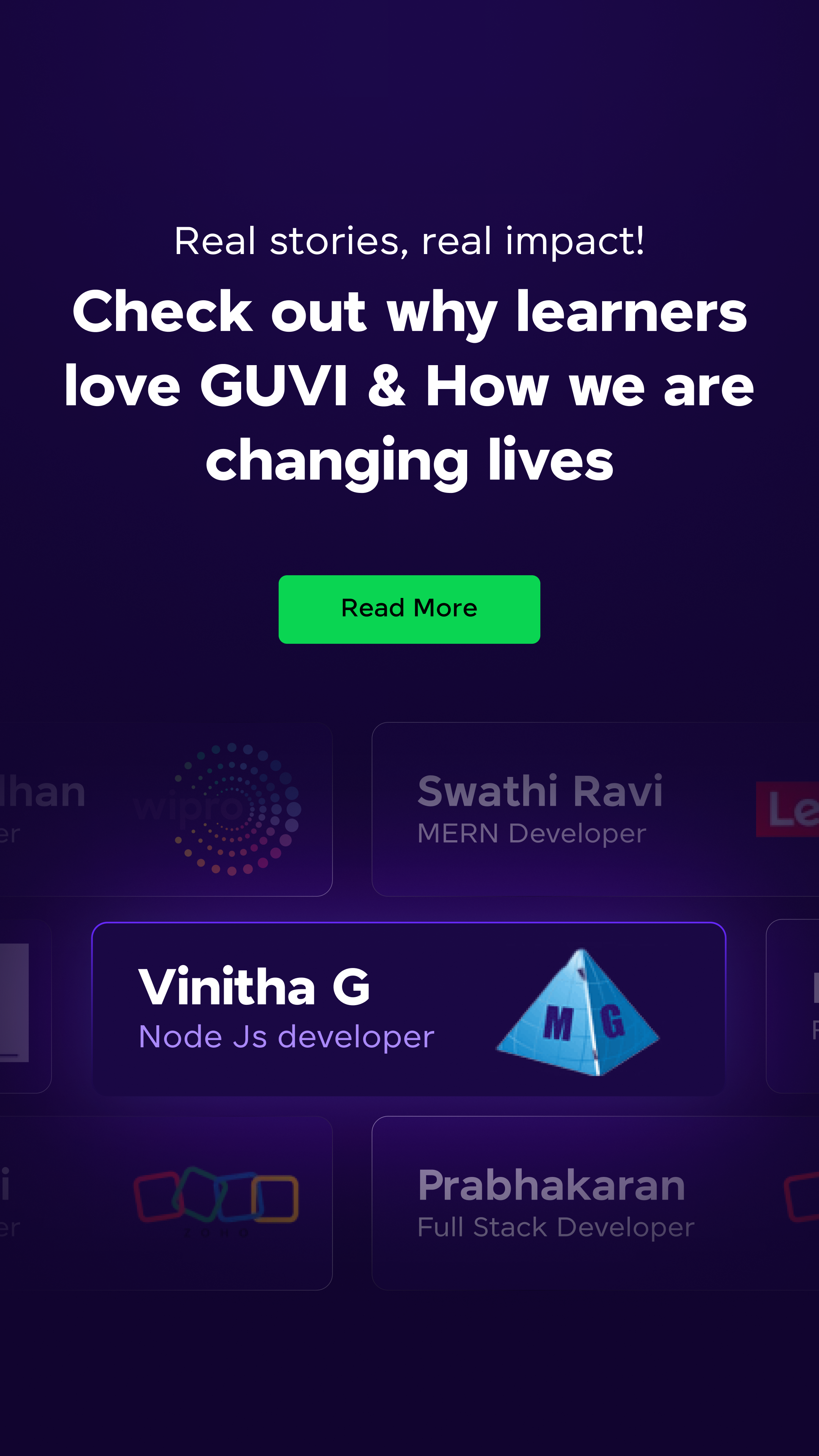























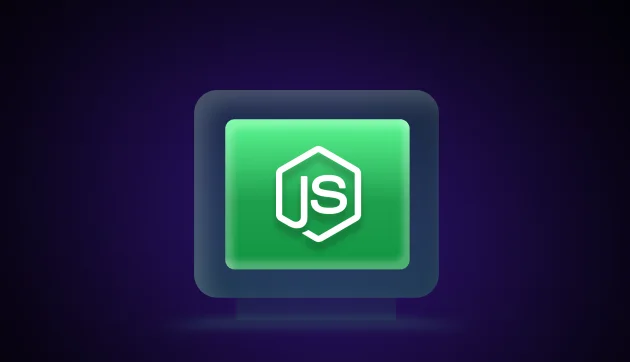
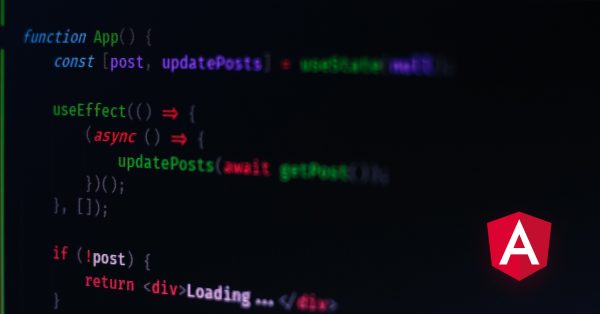
![A Comprehensive Guide to Microservices Architecture and Implementation [2025] 12 Feature Image - A Comprehensive Guide to Microservices Architecture and Implementation](https://www.guvi.in/blog/wp-content/uploads/2024/03/feature_image-1-1.webp)
![Exploring Serverless Architecture: Important Benefits and Challenges [2025] 13 Feature Image - Serverless Architecture](https://www.guvi.in/blog/wp-content/uploads/2024/04/Feature-Image.webp)
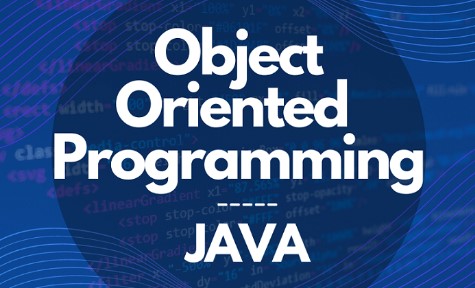

Did you enjoy this article?